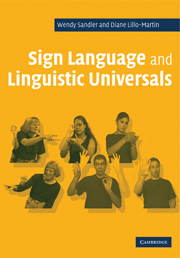Book contents
- Frontmatter
- Contents
- Preface
- Notation conventions
- UNIT I INTRODUCTION
- UNIT II MORPHOLOGY
- UNIT III PHONOLOGY
- UNIT IV SYNTAX
- 17 Syntax: introduction
- 18 Clausal structure
- 19 Clausal structure across sign languages
- 20 Variations and extensions on basic sentence structures
- 21 Pronouns
- 22 Topic and focus
- 23 WH-questions
- 24 Syntax: summary and directions
- UNIT V MODALITY
- References
- Index
22 - Topic and focus
Published online by Cambridge University Press: 05 June 2012
- Frontmatter
- Contents
- Preface
- Notation conventions
- UNIT I INTRODUCTION
- UNIT II MORPHOLOGY
- UNIT III PHONOLOGY
- UNIT IV SYNTAX
- 17 Syntax: introduction
- 18 Clausal structure
- 19 Clausal structure across sign languages
- 20 Variations and extensions on basic sentence structures
- 21 Pronouns
- 22 Topic and focus
- 23 WH-questions
- 24 Syntax: summary and directions
- UNIT V MODALITY
- References
- Index
Summary
Languages vary in the ways that they organize sentences to convey different kinds of discourse information. The term information packaging is used to refer to the ways that discourse-relevant notions such as topic and focus are conveyed in a language. Typically, languages use both sentence structure and prosodic markers for such information, but some languages rely more on one or the other mechanism. For example, English allows stress to shift in a sentence so that focus can be conveyed primarily through prosodic means (although even English has certain structures, such as topicalization and clefting, to rearrange information). On the other hand, Catalan keeps stress in a constant position in the sentence. This means that syntactic movement operations must apply to rearrange constituents so that the focused element is in the correct position to receive stress. In such languages, analyzing even common syntactic structures requires a deeper understanding of the ways in which truth-conditionally identical content may be conveyed.
Sign languages, like spoken Hungarian, Mayan languages, and Catalan, widely exploit syntactic variations as well as prosody for purposes of information packaging. Thus, we are interested in investigating the extent to which the discourse-based sentence structure variation in sign languages falls within the range of possibilities observed in spoken language universals. Here, we overview some of the basic primitives of theories of information packaging. In the following subsections we then take advantage of these primitives in understanding some of the alternative word orders used in ASL and other sign languages.
- Type
- Chapter
- Information
- Sign Language and Linguistic Universals , pp. 404 - 430Publisher: Cambridge University PressPrint publication year: 2006



